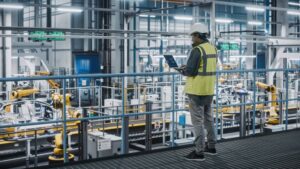The engineering industry is one that is always evolving. Due to the various factors and sub-industries, it may seem easy to feel like you’re falling behind, whether you’re growing your team or applying for new positions. To stay ahead of the competition, it’s vital that you learn about the ever-changing engineering employment trends and industry so you can curb your competitors.
As you transition into 2024, take the time to learn about the hiring trends that will be taking over the industry. This insight will help you develop more reliable hiring strategies, communicate with clients, or, if you’re searching for a job, find the right position.
1. New Engineering Disciplines May Emerge
Due to the emergence and adoption of new technologies, practices within the engineering industry are constantly changing. Adapting to the integration of new technologies across a broad spectrum of industries is crucial for engineers. In 2024, this will be particularly applicable to sectors like construction that are already experiencing significant shifts.
For example, the growing popularity of constructing smart cities has led to the demand for engineers with diverse skillsets to step up. Urban planning, structural safety, and the use of smart technologies are more important than ever now, as the focus on sustainable buildings and green living materials requires advanced knowledge and dedication from engineers.
This trend is predicted to persist beyond 2024. The potential for new engineering specializations with overlapping expertise from diverse fields within the industry is high. In this ever-changing world, it’s important for employers to stay informed about the skills needed for new jobs. In addition, companies will need to adjust their existing positions to include these new roles.
2. In-Office Work Is Becoming More Common
While the pandemic created its own trends in engineering jobs in the form of working remotely, engineers may soon find themselves back in the office. If you have worked from home for the past few years, you probably found a groove and routine that best suits you. However, there are a few ways you and your company can benefit from moving back into an office space:
- Enhanced Collaboration: Engineering projects often rely on a highly collaborative environment so you can communicate and brainstorm more effectively. Whiteboard sessions, quick huddles, and spontaneous discussions can significantly accelerate problem-solving and further innovation compared to solely relying on virtual interactions.
- Access to Resources: Various projects require specific materials, tools, and equipment to successfully complete the job. Oftentimes, these resources cannot be found around the house but in an office instead. Additionally, depending on the specialty, there could be privacy and intellectual property concerns, making a home office less reliable for security reasons.
- Social Setting: Many professionals find that working on-site leads to enhanced productivity, better teamwork, and job satisfaction. While there are pros and cons of being an engineer in a hybrid setting, comparatively, working in an office may enhance your daily life.
3. Large Emphasis on Sustainability
One of the fastest-growing engineering trends is prioritizing sustainability and eco-friendly methods, resources, and long-term plans. This shift impacts all disciplines; for example, civil engineers are finding ways to improve energy efficiency with low-carbon materials, and other engineering specialties are focusing on alternative energy sources.
This is especially important for those in the construction industry, whose expectations and regulations have become a lot more strict. Now, construction professionals need to meet green building demands, all while keeping costs low.
Fortunately, innovations in energy-efficient materials and building practices are paving the way for greener infrastructure, aligning with global goals. Government initiatives are further accelerating this progress by promoting the use of low-carbon materials in major projects.
Sustainability is no longer an experiment but a transformative force shaping the future of engineering and driving the development of innovative solutions for a greener tomorrow.

4. Growing Demand for Workplace Diversity
In today’s rapidly evolving tech landscape, diverse engineering teams are vital to innovation and creativity. By bringing together a mix of perspectives, experiences, and backgrounds, you build a powerhouse capable of tackling complex challenges and exceeding expectations.
Ensuring that you have a diverse team of engineers can lead to:
- More Innovation
- Increased Profits
- Enhanced Values and Ethics
Creating a diverse workforce is not only a fleeting engineering employment trend; it’s a way to set yourself apart from your competition, open the doors to new opportunities, and enhance your reputation as an enjoyable place to work.
To encourage diverse professionals to apply for jobs at your company, it’s important to use the right language that highlights your commitment to diversity and inclusion. Additionally, creating a diverse interviewing team is a good way to make candidates feel at home during the interview process. But above all, it’s crucial to hire professionals for their skills. By creating a strong team, you’ll become a leader in your industry and widen your candidate pool.
5. Continuous Learning Is Becoming a Job Requirement
As technology, best practices, and materials continue to evolve, so does our knowledge. It’s essential that you, as a professional, are dedicated to continuing your education so that you can stay ahead of the curve.
Every aspect of the industry is progressing at lightning speed. New materials, methods, and resources are emerging every day, and it’s your responsibility as an engineer to make sure that you’re ready for changes within your sector. Engineering projects become more and more complex each day, so it’s beneficial to have a broad skillset that can meet your project’s needs.
Committing to lifelong learning allows you to think outside the box and develop innovative solutions. As you apply for new jobs, you’ll set yourself apart from the rest of the talent pool.
6. Trending Technologies Are at the Forefront
Technologies like artificial intelligence and machine learning are not new. They’ve been providing aid to engineers well before 2024. However, as time passes, these resources are being relied on more daily and will eventually become an integral part of the industry.
To stay ahead of tech recruiting trends, it’s important to seek candidates who understand the importance of these technologies and can seamlessly integrate them into their work.
Artificial Intelligence
The integration of artificial intelligence (AI) has fundamentally reshaped the engineering landscape. From design optimization and simulation to automated manufacturing and predictive maintenance, AI algorithms are tackling tasks once considered solely within the human domain. This has led to significant improvements in efficiency, accuracy, and innovation, enabling engineers to push the boundaries of their fields.
Machine Learning
Machine learning, a subset of AI, has emerged as a resourceful tool for engineers. This technology allows algorithms to learn and adapt from data, continuously improving their ability to perform specific tasks. Within engineering, machine learning empowers numerous applications, including materials science, where algorithms predict material properties for optimal design, and robotics, where machines learn to operate with greater precision and autonomy.
At Austin Nichols Technical Search, we are dedicated to helping companies grow their teams, and professionals find their next opportunity. Contact us today and allow our expert recruiters to help you stay on top of these engineering employment trends.










